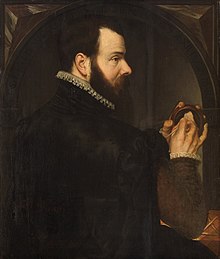Willem van den Broeck

Willem van den Broeck (* 1530 in Mechelen ; † 1580 Antwerp ), known as Guillelmus Paludanus , was a Flemish sculptor of the Renaissance.
Life
Willem van den Broeck was the brother of the painters Crispin van den Broeck and Hendrick van den Broeck . He is in 1557 as a free master of the Guild of St. Luke demonstrated in Antwerp and has 1,559 citizens. In 1566/67 he received payments for three statues that were placed under the crucifix in the Cathedral of Our Lady . In 1571/73 he worked for the monastery of San Leonardo in Alva . The pedestal of the statue of Duke Albas erected in the citadel of Antwerp in 1571 came from him. This monument was destroyed in 1577.
Alabaster reliefs have been preserved from him in northern Germany : five reliefs with "Alabaster histories" in the chapel of Schwerin Castle , the "Elevation of the Bronze Snake" signed by him is considered a rare treasure for Schwerin . The alabaster was personally selected by Duke Johann Albrecht I in 1562 in a quarry near Uslar in Solling, which was then newly opened . In Lübeck Cathedral you can also find his alabaster reliefs such as the "Ascension of Christ" on the pulpit of the Dutch stonemason Hans Fleminck from 1568.
Other alabaster reliefs by him: a Calvary in the Louvre and a Garden of Eden in Brussels.
literature
- Broeck, Guillaume van den . In: General Artist Lexicon . The visual artists of all times and peoples (AKL). Volume 14, Saur, Munich a. a. 1996, ISBN 3-598-22754-X , p. 324.
- Edmond-Louis de Taeye: Broeck (Broecke, Broueke etc. also Poel) called Paludanus, Paledaen, Palidamus etc., Guillaume or Willem van den . In: Ulrich Thieme (Hrsg.): General Lexicon of Fine Artists from Antiquity to the Present . Founded by Ulrich Thieme and Felix Becker . tape 5 : Brewer-Carlingen . EA Seemann, Leipzig 1911, p. 45 ( Textarchiv - Internet Archive ).
- Wolfgang Grusnick, Friedrich Zimmermann: The Lübeck Cathedral. Langewiesche publishing house, Königstein iT, 1996, ISBN 3-7845-0827-8
- Friedrich Schlie : The art and history monuments of the Grand Duchy of Mecklenburg-Schwerin. Volume II: The district court districts of Wismar, Grevesmühlen, Rehna, Gadebusch and Schwerin. Schwerin 1898, reprinted Schwerin 1992, ISBN 3-910179-06-1 .
- Martin Espenhorst (Ed.) Ignorance and misunderstandings in the premodern peace process. Vandenhoeck & Ruprecht, Göttingen 2013, ISBN 978-3-525-10127-8 .
Single receipts
- ↑ Ignorance and misunderstandings in the premodern peace process. P. 53 (statue of Duke Albas).
- ↑ Schlie: The district court districts of Wismar, Grevesmühlen, Rehna, Gadebusch and Schwerin. P. 589 ff.
- ↑ Figure ( page no longer available , search in web archives ) Info: The link was automatically marked as defective. Please check the link according to the instructions and then remove this notice. from the Mecklenburg monthly magazine 1926.
- ↑ Schlie: The district court districts of Wismar, Grevesmühlen, Rehna, Gadebusch and Schwerin. P. 586.
- ↑ Figure
- ↑ Figure
| personal data | |
|---|---|
| SURNAME | Broeck, Willem van den |
| ALTERNATIVE NAMES | Broeck, Guillaume van den; Broecke, Willem van den; Poel, Guillaume van den; Poel, Willem van den; Broueke, Guillaume van den; Broueke, Willem van den; Paludanus, Guillaume van den; Paludanus, Willem van den; Palidanus, Guillaume van den; Palidanus, Willem van den; Paludano, Guillermo; Paledaen, Guillaume; Paledamus, Guillaume |
| BRIEF DESCRIPTION | Flemish Renaissance sculptor |
| DATE OF BIRTH | 1530 |
| PLACE OF BIRTH | Mechelen |
| DATE OF DEATH | 1580 |
| Place of death | Antwerp |